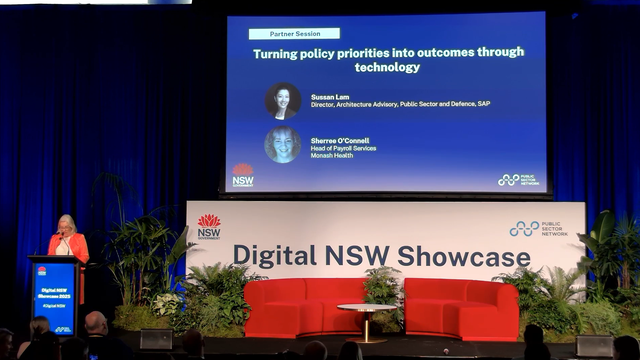Hitting Digital Transformation Targets across the Public Sector
Achieving Digital Transformation across the Australian Public Service by 2025
A new data government data sharing Scheme
The first half of 2022 in Australian politics was largely seen as the election period, with a lot of combative electioneering on both sides. Yet a number of pieces of legislation were also passed, including many important bills with bipartisan support but without great fanfare. Once such statute was the ‘Data Availability and Transparency Act 2022’, known as the Data Act or Data Scheme for short, which came into being on 1 April. Kelly Wood , the Acting Assistant Secretary at the Office of the National Data Commissioner (ONDC), which sits within the Department of Prime Minister and Cabinet, says that despite the change of government, “the previous government worked very hard with the current government while they were in opposition, to secure that bipartisan support.” This bodes well for the Scheme, because it is designed to allow “governments (federal, state and territory) to do even more with data, to realise its full potential, and for a future where the Australian government is best in class manager and user of data.” This in turn is part of the overall goal of government, “to achieve digital transformation across the Australian public service by 2025.”
Ultimately the Data Scheme is focussed on “increasing the availability and use of Australian government data,” so that it helps government to deliver services that are “simple, helpful, respectful and transparent,” allowing government to operate better. This creates great possibilities, and thus the ONDC is always optimistic, “believing that the best is always yet to come.”
The importance of data sharing
Data has largely become a “significant world currency,” with the volume of data “growing at an exponential rate.” In a practical Australian sense, during the global financial crisis a little over a decade ago, Australian government officials, who were involved in trying to alleviate the crisis, “observed that it was like looking through fogged up glasses at the road behind us.” So poor was the data quality and their ability to use it. However, during the height of the pandemic, those same officials “were able to draw on near real-time data to see the road they were on.” This is largely because of technological advances and the ability to share data, which has led to “better government programs and policies, helping the vaccine roll out and schemes such as JobKeeper and JobSeeker.” From a departmental perspective, many of these recent successes were underpinned by the ‘Multi-Agency Digital Integration Project’, which “seeks to bring all the datasets together.” However, for quite a while there was a case of “the law needing to catch up with the technology.” The Data Scheme was enacted partly to solve that.
The Scheme has three main goals, “for three data sharing purposes:”
The Scheme also allows “Australian government agencies to override existing legislative barriers to share data,” as well as to have “safe best practices for sharing data.”
In many ways, what has now become the Data Scheme has its origins in “recommendations made by the Productivity Commission following their comprehensive inquiry into data availability and use.” That inquiry found that there were “legislative barriers for sharing data, along with a culture of caution around data sharing.” This led to the formation of the ONDC in 2017 as a way of overseeing “a simpler and more efficient data sharing and release framework,” and also to assist in creating new legislation and “appropriate safeguards” in this space. This new Scheme, with its three purposes, has “endless opportunities, and they exist for Australian government data to be used for that public benefit, including by Australian universities to help support research and development.”
Using the data Scheme for greater benefit
Although the intention of the Scheme is to share data and use it in a way that benefits as many people and agencies as possible, the ONDC created safeguards so that there are no breaches. As such, there are three types of users of the Scheme: “accredited data users, who are government bodies and universities who can make a request for data from an Australian government agency; data custodians, like the agencies themselves so that data can be shared across and within government agencies; and accredited data service providers, like the ATO or the ABS, who can provide specialised data services such as complex data integration, de-identification and secure access data services to support data sharing projects.” At this stage, “only Australian entities” can participate, whilst some entities, like the AFP, “are excluded for national security and other reasons.” This is in part because data can only be accessed or shared if it is “in the public interest,” and “cannot be shared for enforcement or compliance purposes under this legislation.” On top of that, the Scheme works in concert with the Privacy Act and all the users need to be accredited, meaning they need authority from their agencies. Custodians don’t have a duty to share their data, but if they refuse, “they must provide reasons to accredited users explaining why they refused a request to share.” An annual review of all these practices will take place, and there may be amendments as the Scheme progresses.
As mentioned, the Scheme passed with bipartisan support, but one of the sticking points was privacy. As such, the Scheme has a “privacy-by-design approach built into it, to protect the privacy rights of individuals and to ensure that the Scheme works concurrently with privacy law.” This means that unless otherwise stated or specifically requested, all data “is de-identified” and does “not include personal information.” It is also encouraged that all data sharing projects “also take the privacy-by-design approach.”
There is no data yet about how successful the Scheme is as it was only due to become active and live on 1 June, with universities only being “able to apply for accreditation from the 1 August.” However, as the regulator of the Scheme, the ONDC has already “provided advice, guidance and tools to support the data sharing step change.” On top of that, there are two further initiatives to assist agencies. The first is the Data Discovery opportunity, which is “focussed on making it easier for Australian government agencies to understand and catalogue data holdings.” This will make data inventories “consistent and searchable,” and will help “solve the age old question of what data do you want; what data do you have?”
The second initiative is Data Place, which is “an $11 million commitment for managing data sharing requests in a more timely and efficient manner.” It will “provide a single place to facilitate connections between organisations seeking data, and will make it simpler to manage data requests with a streamlined, consistent, online process.”




































